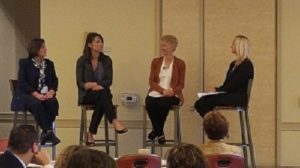 SME Panel: Rick Johnson, J.D. Power and Associates; Dana Hyatt, Customer Experience Professionals Association
SME Panel: Rick Johnson, J.D. Power and Associates; Dana Hyatt, Customer Experience Professionals Association
HERO Member Panel: Patty Ann Hawes, RN, MS, BSN, COHN, National Security Agency; Patty Purpur de Vries, MS, Stanford University; Shelly Wolff, Willis Towers Watson
On February 23-24, HERO members gathered in San Antonio, Texas for our Winter Think Tank on the topic of “The Employee Experience.” While many industries are well known for their deep reliance on the voice of their consumers, employee health and well-being initiatives have arguably been oriented toward a business case responsive to the needs of the employer. Does the movement “from wellness to well-being” signal a shift away from costly employee risks to the organizational value added if we better tap employee assets, needs, and diversity?
To address these questions and serve as conversation starters for our Think Tank members, our subject matter experts introducing key concepts and approaches to measuring and applying “voice of the customer” to organizational change and ongoing product and process improvements [recording]. In doing so, they encouraged us to think about how we would leverage the voice of the employee as our “customer” for health and well-being initiatives.
Rick Johnson [slides] from J.D. Power and Associates teed up our topic by familiarizing us with common tools to measure customer experience including Net Promoter Score, which J.D. Power augments with their proprietary customer engagement indexes to deepen their understanding of satisfaction and loyalty measures. He also described the process they use to measure and manage the customer experience. Dana Hyatt [slides], a customer experience professional, examined the link between employee engagement and customer experience, sharing the approach she uses when working with organizations to most effectively leverage customer experience data to drive organizational change. She noted the importance of considering how the organization thinks about the customer experience and to first understand “what’s your why” when measuring the customer experience. Both presenters noted the need to approach “voice of the customer” as an entire systems approach where data informs changed processes and resource use, with the support of change management strategies.
Moving from the conceptual to application, a HERO member reactor panel shared how they’ve been using “voice of the employee” data to inform ongoing improvements to their health and well-being initiatives. Patty Purpur de Vries from Stanford shared how repeat administration of a physician survey identified links between professional fulfillment, burnout, and turnover. External and internal data on cost of turnover gained the support of management to examine contributors to burnout, and their discoveries have inspired a new approach to their physician wellness initiative. Patty Ann Hawes from the National Security Agency shared how they were able to add 20 questions to their annual climate survey, which revealed a surprising finding that a majority of employees said they did not have the energy to do their job and get through the day. This finding prompted a shift in their focus to provide more resources related to energy management and sleep health. Shelly Wolff from Willis Towers Watson drew on her experience working with numerous employers to share how their clients are measuring and applying employee engagement data in their organizations to drive business results.
Robust roundtable discussions followed with members identifying key takeaways and applications as they considered how to apply “voice of the customer” approaches to refine their health and well-being initiatives. Some common themes include:
• Transparency is needed to ensure employees understand how the data will be used, what the boundaries are for expected change, and how their input informed ongoing improvements.
• We can use “voice of the customer” approaches to better tailor our offerings to sub-populations with specific interests or needs. Data can inform more relevant choices for employees to select from.
• We cannot collect data without understanding how and why we wish to use it.
• As we’ve learned to listen more closely to employee voice, we are understanding the need to shift to a more comprehensive well-being approach.
• Employers get employee feedback through surveys (annual and more frequent pulse), participation data, via wellness champion feedback, town hall meetings, etc.
• We need to measure repeatedly over time, not once and done. Need to embed voice of the customer approach into organizational culture.
• We need to better integrate health and well-being data with employee engagement/morale/loyalty data.
